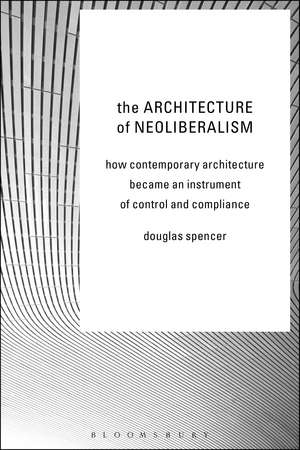The Architecture of Neoliberalism: How Contemporary Architecture Became an Instrument of Control and Compliance
Autor Douglas Spenceren Limba Engleză Hardback – 19 oct 2016
| Toate formatele și edițiile | Preț | Express |
|---|---|---|
| Paperback (1) | 167.08 lei 3-5 săpt. | |
| Bloomsbury Publishing – 20 sep 2023 | 167.08 lei 3-5 săpt. | |
| Hardback (1) | 714.51 lei 6-8 săpt. | |
| Bloomsbury Publishing – 19 oct 2016 | 714.51 lei 6-8 săpt. |
Preț: 714.51 lei
Preț vechi: 914.61 lei
-22% Nou
Puncte Express: 1072
Preț estimativ în valută:
136.72€ • 142.75$ • 113.15£
136.72€ • 142.75$ • 113.15£
Carte tipărită la comandă
Livrare economică 04-18 aprilie
Preluare comenzi: 021 569.72.76
Specificații
ISBN-13: 9781472581525
ISBN-10: 1472581520
Pagini: 232
Ilustrații: 30 B&W illus
Dimensiuni: 156 x 234 x 15 mm
Greutate: 0.48 kg
Editura: Bloomsbury Publishing
Colecția Bloomsbury Academic
Locul publicării:London, United Kingdom
ISBN-10: 1472581520
Pagini: 232
Ilustrații: 30 B&W illus
Dimensiuni: 156 x 234 x 15 mm
Greutate: 0.48 kg
Editura: Bloomsbury Publishing
Colecția Bloomsbury Academic
Locul publicării:London, United Kingdom
Caracteristici
Engages with prominent figures and practices at the forefront of global contemporary architecture - whose ideas and works, though familiar, are rarely afforded sustained critical analysis
Notă biografică
Douglas Spencer teaches and writes on critical theories of architecture, landscape and urbanism. A regular contributor to Radical Philosophy, he has also written chapters for collections such as Architecture Against the Post-Political (2014), Landscape and Agency (2016) and This Thing Called Theory (2016). He has published numerous essays in journals such The Journal of Architecture, AD, AA Files, New Geographies, Volume and Praznine. He teaches at the AA's Graduate School of Design at the Architectural Association and at the University of Westminster, London.
Cuprins
Introduction: Architecture, Neoliberalism and the Game of Truth1. The Art of Neoliberal Governmentality2. The Spatial Constitution of the Neoliberal Subject3. Architecture Theory: From May '68 to the 'Real' of the Market4. Labour Theory: Architecture, Work and Neoliberalism5. Festivals of Circulation: Neoliberal Architectures of Culture, Commerce and Eduction6. Neoliberalism and Effect: Architecture and the Patterning of ExperienceConclusion: The Necessity of CritiqueBibliography
Recenzii
Spencer draws a direct intellectual lineage from neoliberalism's original thinkers through the unlikely corridors of late-20th-century countercultural and avant-garde thought, all the way into the glistening hallways of today's most acclaimed contemporary architectural firms.
This book marks a milestone in architectural criticism, and the questions it addresses could not be more important or urgent ... Its bold, unflinching description of architecture's complicity with the powers that be makes it an indispensable reference for all those concerned with the social and political meaning of their work,
The Architecture of Neoliberalism is a devastating portrait of contemporary architecture as the phantasmagoria of neoliberal capitalism. Spencer deftly deconstructs the current architectural ideology as a melange of counter-cultural tropes and vitalist celebrations of flexibility, empowerment, spontaneity, and the market as the final arbiter of freedom. The result is a powerful plea for critique in the face of the architectural prophets who proclaim 'there is no alternative'.
"Neoliberalism" is commonly used as an epithet today to denounce a late-capitalist architecture in cahoots with the forces of real estate development and the marketplace. Douglas Spencer is the first to provide a detailed history of this term and to analyze its modes of operation, its architectural expressions, and its ideological subterfuges. An absolutely timely, lucid, important critique.
This book marks a milestone in architectural criticism, and the questions it addresses could not be more important or urgent.
This book marks a milestone in architectural criticism, and the questions it addresses could not be more important or urgent ... Its bold, unflinching description of architecture's complicity with the powers that be makes it an indispensable reference for all those concerned with the social and political meaning of their work,
The Architecture of Neoliberalism is a devastating portrait of contemporary architecture as the phantasmagoria of neoliberal capitalism. Spencer deftly deconstructs the current architectural ideology as a melange of counter-cultural tropes and vitalist celebrations of flexibility, empowerment, spontaneity, and the market as the final arbiter of freedom. The result is a powerful plea for critique in the face of the architectural prophets who proclaim 'there is no alternative'.
"Neoliberalism" is commonly used as an epithet today to denounce a late-capitalist architecture in cahoots with the forces of real estate development and the marketplace. Douglas Spencer is the first to provide a detailed history of this term and to analyze its modes of operation, its architectural expressions, and its ideological subterfuges. An absolutely timely, lucid, important critique.
This book marks a milestone in architectural criticism, and the questions it addresses could not be more important or urgent.
